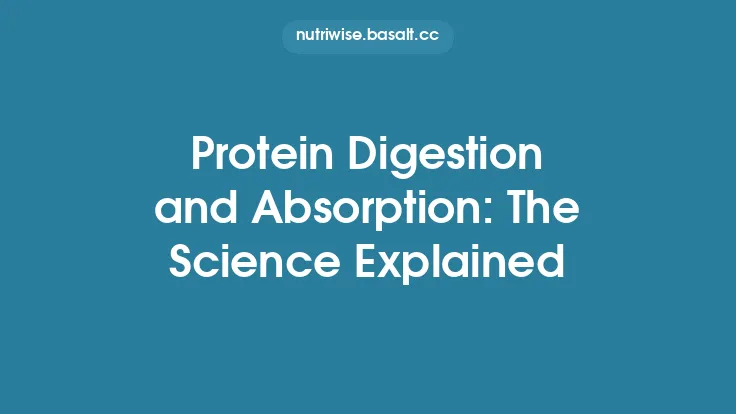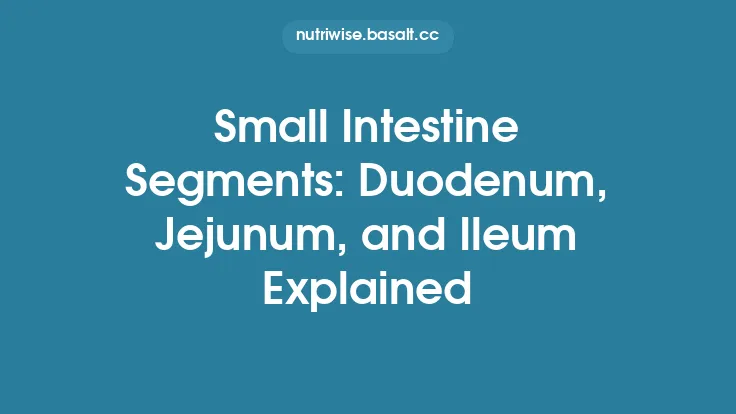The inner lining of the small intestine is a marvel of biological engineering. Its primary mission is to extract every usable nutrient from the chyme that passes through, and it does so by dramatically expanding the available surface for exchange. This expansion is achieved through a hierarchical arrangement of protrusions: the macroscopic villi that line the intestinal wall, and the microscopic microvilli that crown each epithelial cell. Together, they create a “brush‑border” architecture that maximizes contact between digested molecules and the transport machinery of the enterocyte. Understanding how these structures are built, how they function, and how they adapt to physiological demands provides insight into one of the most efficient absorption systems in the human body.
Anatomical Structure of Villi
Villi are finger‑like projections that extend from the mucosal surface of the small intestine into the lumen. Each villus measures roughly 0.5–1 mm in length and 0.1–0.2 mm in diameter, although dimensions vary along the duodenum, jejunum, and ileum. The core of a villus is a lamina propria rich in connective tissue, fibroblasts, and a dense network of capillaries and lacteals (central lymphatic vessels). This core is sheathed by a thin layer of smooth muscle called the muscularis mucosae, which can contract to modulate villus height and thereby influence the exposure of the epithelial surface.
The epithelial covering of each villus is a single layer of columnar cells, predominantly enterocytes, interspersed with goblet cells, Paneth cells, and enteroendocrine cells. The tight junctions between enterocytes form a selective barrier that regulates paracellular transport while preserving the polarity essential for vectorial nutrient movement.
Microvilli and the Brush Border
At the apical surface of every enterocyte lies a dense array of microvilli, each 0.5–1 µm long and 0.1 µm in diameter. These are not independent structures; rather, they are supported by a core bundle of actin filaments (approximately 20–30 filaments per microvillus) that are cross‑linked by fimbrin, villin, and espin. The actin core is anchored to the terminal web—a sub‑apical network of intermediate filaments and spectrin—that provides structural stability.
The collective surface of microvilli forms the brush border, which can increase the absorptive area of a single enterocyte by up to 30‑fold. When multiplied across the millions of villi lining the small intestine, the total effective surface area for absorption reaches an estimated 200–250 m²—comparable to the size of a tennis court.
Enzymatically, the brush border is a hotspot for membrane‑bound hydrolases such as lactase, sucrase‑isomaltase, maltase‑glucoamylase, and peptidases. These enzymes complete the final steps of carbohydrate and protein digestion directly at the site of absorption, ensuring that monosaccharides and di‑/tripeptides are readily available for transport.
Cellular Composition and Specialized Cells
- Enterocytes: The workhorses of absorption, equipped with a repertoire of transporters (e.g., SGLT1 for glucose, PEPT1 for di‑/tripeptides, and various amino acid transporters). Their basolateral membranes contain Na⁺/K⁺‑ATPase pumps that maintain the electrochemical gradients driving secondary active transport.
- Goblet Cells: Interspersed among enterocytes, they secrete mucins that form a protective mucus layer over the epithelium. This layer traps pathogens and lubricates the luminal surface while allowing diffusion of nutrients.
- Paneth Cells: Located at the base of the crypts of Lieberkühn (the invaginations between villi), they release antimicrobial peptides (defensins, lysozyme) that shape the intestinal microbiota and protect the stem cell niche.
- Enteroendocrine Cells: Though sparse, they release hormones such as cholecystokinin (CCK), secretin, and glucagon‑like peptide‑1 (GLP‑1) that modulate digestive secretions, motility, and insulin release, indirectly influencing absorptive efficiency.
Mechanisms of Nutrient Absorption
Absorption across the brush border proceeds via three principal pathways:
- Carrier‑Mediated Transport: Specific membrane proteins bind substrates on the apical side and undergo conformational changes to release them intracellularly. For example, the sodium‑glucose linked transporter 1 (SGLT1) couples glucose uptake to the inward movement of Na⁺, exploiting the Na⁺ gradient maintained by the basolateral Na⁺/K⁺‑ATPase.
- Facilitated Diffusion: Transporters such as GLUT2 allow passive movement of glucose down its concentration gradient, typically after a high‑carbohydrate meal when intracellular glucose concentrations rise.
- Endocytosis and Transcytosis: Larger molecules (e.g., immunoglobulins in neonates) can be internalized via receptor‑mediated endocytosis and shuttled across the cell to the basolateral side. This pathway is limited in adults but remains a critical route for certain nutrients and therapeutic agents.
The microvillar membrane also harbors ion channels (e.g., CFTR for chloride) and tight‑junction proteins (claudins, occludin) that regulate paracellular permeability, allowing selective passage of water and electrolytes alongside transcellular transport.
Regulation of Surface Area
The intestine can dynamically adjust its absorptive surface in response to dietary and hormonal cues:
- Villus Height Modulation: Chronic high‑carbohydrate or high‑protein diets stimulate villus elongation, increasing the absorptive area. Conversely, malnutrition or prolonged fasting leads to villus atrophy.
- Microvillar Length Alteration: Acute hormonal signals (e.g., glucagon‑like peptide‑2, GLP‑2) can induce rapid elongation of microvilli within hours, enhancing brush‑border enzyme density.
- Enterocyte Turnover: The epithelium renews itself every 3–5 days. Stem cells in the crypts proliferate, differentiate, and migrate upward to replace aged enterocytes, ensuring a consistently functional absorptive surface.
Developmental Biology of Intestinal Projections
During embryogenesis, the small intestine transitions from a smooth tube to a highly folded organ. Key molecular pathways orchestrate villus formation:
- Hedgehog Signaling: Sonic hedgehog (Shh) and Indian hedgehog (Ihh) secreted by the endoderm regulate mesenchymal proliferation, setting the stage for villus emergence.
- BMP (Bone Morphogenetic Protein) Gradient: A BMP gradient from the mesenchyme to the epithelium defines the spacing and size of villi.
- Wnt/β‑Catenin Pathway: Critical for crypt formation and maintenance of the stem cell niche; dysregulation can lead to aberrant villus architecture.
Microvilli appear later, as enterocytes differentiate and express actin‑bundling proteins (villin, espin). The coordinated expression of these proteins ensures the uniformity and stability of the brush border.
Pathophysiology: When Villi and Microvilli Fail
Several disease states directly impair the structure or function of villi and microvilli:
- Celiac Disease: An autoimmune reaction to gluten leads to villous atrophy, crypt hyperplasia, and loss of brush‑border enzymes, resulting in malabsorption of fats, carbohydrates, and micronutrients.
- Tropical Sprue: Chronic infection or inflammation causes partial villous flattening and reduced microvillar enzyme activity, mimicking celiac disease clinically.
- Microvillus Inclusion Disease (MVID): A rare congenital disorder caused by mutations in the MYO5B gene, leading to defective trafficking of brush‑border proteins and the formation of intracellular microvillus inclusions. Affected infants present with severe, intractable diarrhea.
- Chemotherapy‑Induced Mucositis: Cytotoxic agents damage rapidly dividing enterocytes, causing temporary villus blunting and reduced absorptive capacity.
- Infectious Enteritis: Pathogens such as *Vibrio cholerae or Enterotoxigenic E. coli* secrete toxins that disrupt tight junctions and can cause reversible microvillar shedding.
Understanding the morphological changes in these conditions guides both diagnostic strategies and therapeutic interventions.
Diagnostic and Research Techniques
- Histology and Electron Microscopy: Light microscopy with hematoxylin‑eosin staining reveals villus height and crypt depth, while transmission electron microscopy (TEM) visualizes microvillar density, actin core organization, and brush‑border enzyme localization.
- Immunohistochemistry (IHC): Antibodies against villin, sucrase‑isomaltase, or SGLT1 allow precise mapping of brush‑border components.
- Confocal Laser Scanning Microscopy: Enables three‑dimensional reconstruction of villus architecture and quantification of surface area in intact tissue sections.
- In Vivo Functional Tests: D‑xylose absorption tests and oral glucose tolerance tests indirectly assess absorptive capacity, reflecting the integrity of villi and microvilli.
- Organoid Cultures: Intestinal stem‑cell‑derived organoids recapitulate villus‑crypt architecture in vitro, providing a platform to study genetic mutations (e.g., MYO5B) and test pharmacologic agents that may promote villus regeneration.
Implications for Nutrition and Health
The efficiency of nutrient uptake hinges on the health of villi and microvilli. Dietary components can modulate their structure:
- Short‑Chain Fatty Acids (SCFAs): Produced by microbial fermentation of dietary fiber, SCFAs (especially butyrate) stimulate enterocyte proliferation and enhance villus height.
- Glutamine: A primary fuel for enterocytes; supplementation can accelerate villus recovery after injury.
- Polyphenols: Certain flavonoids (e.g., quercetin) have been shown to upregulate brush‑border enzyme expression, potentially improving carbohydrate digestion.
Conversely, chronic alcohol consumption, smoking, and high‑fat diets can induce villus blunting and reduce microvillar enzyme activity, contributing to malabsorption and dysbiosis.
Future Directions in Research
- Targeted Growth‑Factor Therapies: Recombinant GLP‑2 analogs (e.g., teduglutide) are already used to treat short bowel syndrome by promoting villus growth. Ongoing trials aim to refine dosing and combine them with agents that specifically enhance microvillar length.
- Gene Editing for Congenital Disorders: CRISPR‑based correction of MYO5B mutations in intestinal organoids offers a potential avenue for treating MVID.
- Microbiome‑Mediated Modulation: Manipulating the gut microbiota to increase SCFA production may become a non‑pharmacologic strategy to sustain villus health.
- Nanoparticle Delivery Systems: Exploiting the high surface area of the brush border, researchers are designing nanoparticle carriers that adhere to microvilli for targeted drug delivery, improving oral bioavailability of poorly absorbed compounds.
- Advanced Imaging: Light‑sheet fluorescence microscopy and intravital two‑photon imaging are poised to provide real‑time visualization of nutrient transport across the brush border in living animals, deepening our mechanistic understanding.
The intricate partnership between villi and microvilli exemplifies how structural specialization can dramatically amplify physiological function. By expanding the absorptive interface, these microscopic architects ensure that the body extracts maximal nutritional benefit from each meal. Continued exploration of their biology not only enriches fundamental science but also opens pathways to treat a spectrum of malabsorptive disorders, optimize nutrition, and innovate drug delivery technologies.





